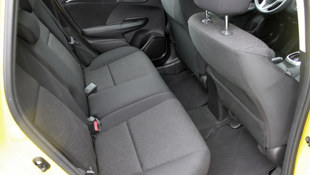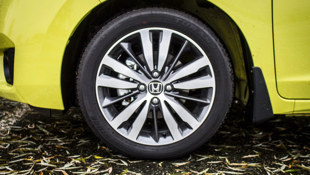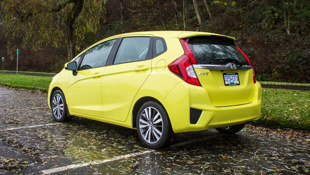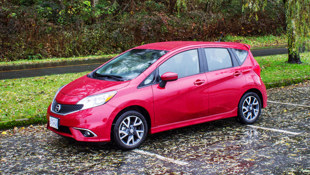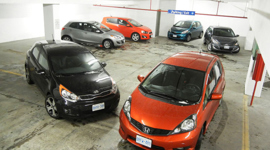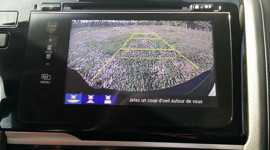Comparison Data
|
Base Price
$19,195
|
$18,698
|
|---|---|
|
A/C Tax
$100
|
$100
|
|
Destination Fee
$1,995
|
$1567
|
|
Price as Tested
$22,725
|
$20,500
|
|
Optional Equipment
$135 (Metallic Paint); $1300 (CVT)
|
$135 (Metallic Paint)
|
Review and photos by Dan Heyman & Brendan McAleer
Dan says:
Breadboxes. Mini-MPVs. Subcompact hatchbacks.
That last one is probably the most accurate descriptor, but it’s also the most boring and I think the Honda Fit and Nissan Versa Note deserve more than that. These are two cars that drive well, look pretty good (if a little, well, identical) and are able to pack a lot more than their exterior dimensions suggest thanks to smart cargo management.
[Brendan: Dan's not kidding on the whole identical thing. While taking a quick shot or two in an open lot, a security guard approached and was more than a little befuddled by the idea of this comparison test:
“But they aren't just the same car?”
They also come fairly well equipped considering their middling trim levels, which is not something that could be said for cars of this stature a mere five years ago.
Comfort
Let it be known that the space provided by both of these vehicles is outstanding considering the segment in which they reside, and a far, far cry from what you used to get from the subcompact segment.
You sit nice and high in each, giving a commanding view out both forward and over-the-shoulder trouble spots. The Versa is actually a little better in this regard thanks to a pair of nicely tapered D-pillars. Also nice about the Note is how you kind of get the impression that you step down into it more than you do into the Fit, which is a nice quality to have, especially for shorter drivers. Both cars, meanwhile, have height-adjustable driver’s seats, although you have to have at least an SV trim to get this in the Versa, while the Fit gets it as standard.
What the Fit also gets as standard no matter the trim is a tilt and telescoping steering wheel, while the Note only gets a tilting option. For taller drivers like myself [Dan is, like, seven feet tall! Okay, 6’4”… –Ed.], this can be a real problem. I’d have to move the seat back, and I’d end up having an uncomfortable reach to the tiller. It wasn’t so bad that I couldn’t turn the wheel properly, but I would get some shoulder soreness on longer rides. This needs to be fixed.
The Note wins in the headroom department both front and rear, however, where it beats the Fit by 34 mm and 11 mm, respectively. That’s a split hair, though; the available passenger space in both of these is fantastic considering how tightly packaged they are. I’d take the cushier seats in the Fit, though; the Note’s items just don’t have wide enough bottom cushions.
Versatility
Brendan says:
Is more asked of any vehicle than a subcompact? A minivan, perhaps, but these little escape pods also have to do it all – haul the kids, haul the groceries, haul a load of Blorats and Neeflors home from Ikea, haul away Jimmy the Snitch's mortal remains... Basically, while the subcompact might be thought of south of the border as just a commuter or a college-kid special, that peculiar Canadian affinity for the small car means we expect more from our wee hatchbacks. One of these cars delivers the goods. The other is basically Dr. Who's TARDIS.
A half decade ago, we would have just said something along the lines of: “Buy the Versa for comfort, buy the Fit for agility and fancy folding seats.” These days, as Dan has noted, the Nissan effort is slightly roomier, especially out back, but the Fit is just as comfortable.
Start folding everything up, down and sideways, and the Fit is the runaway winner here. A few points go back to the Note for its multi-level floor (does anyone remember that dealer-installed trunk-organizer the size of a cooler?), and slightly larger overall trunk space. We broke out the tape measure here, and both the Fit and the Note were nearly identical, so those extra 60L claimed by Nissan aren't immediately obvious (unless you own a ping-pong ball company).
But start asking more from your little car and the Fit perks right up. It's utterly ridiculous how much stuff you can – ahem – fit into a car this small. It's like Honda sent the thing to clown college. The seatbacks fold properly flat, meaning unsuccessful Matt Foley types can kip down by the river, or flip up the seat bottoms to take home a potted plant, or a weird piece of furniture, or a keg full of bee- um, soda pop.
The Versa's perfectly acceptable for the segment. The Fit is so good I don't understand why all manufacturers don't immediately ninja-raid Honda's corporate HQ and steal the blueprints.
Tech
Dan says:
It’s a pretty close battle at the outset, but it’s surprising to find out how much more tech you get with the Honda. There’s the Honda LaneWatch tech that turns your infotainment display into a blind-spot camera, a multi-angle rear view camera (the Note has one, too, but it doesn’t get Nissan’s fantastic AroundView tech), power up/down windows, but we couldn’t find a way to stream audio through Bluetooth in the Note, which was no problem in the Fit. The Honda also gets six speakers to the Note’s four; that’s what you get with the Honda, too, on the bottom two trim levels.
Where the Note does gain some points back, however, is in the interface department. You see, the Honda relies solely on its five-inch touchscreen for all your infotainment controls, including the volume, which is a super finicky vertical slider/touchpad that’s too small, but then offers expand when you touch it. Even the power button is tiny, and easy to miss. With the Note, you get proper knobs for your tuner and volume, which is perfect. Both cars get nice, big dials for their climate control, however. Speaking of climate: The Fit gets heated seats as standard from the LX up. Not so the Note SR, even though the SL, which starts at a lower MSRP, gets them.
Driving
OK, I’ll get it right out there to start. I understand full well what continuously variable automatic transmissions (CVTs) are all about, but that doesn’t mean I like them, in particular. They’re good on gas, I’ll give them that, but they tend to rob some (all?) of the excitement (involvement… whatever) from the driving experience. With little cars like this, well, you want to delve into their fun-to-drive elements from time to time.
The Nissan is the CVT vet, here, in that it uses a type of transmission that has been used in Nissan products since the early ‘90s. More recently, the previous-generation Versa used it, while this is the first time we’ve seen Honda’s adaptation of the tech in the Fit.
Having said that, as similar as they look, the two cars do display distinctive variations in the drive.
For starters, the Fit is equipped with wheel-mounted paddle shifters, meaning you can “swap” cogs on your own; in fact, what you’re doing is choosing from a set of predetermined virtual ratios, that help make it feel like you’re actually shifting gears. Nissan doesn’t provide the Note with these at any trim level, even our SR tester, which is supposed to be the sporty trim of the four available. It’s a strange choice, especially considering that Nissan has this tech on other cars in the lineup, and it works rather well there.
Then again, maybe it’s not as strange as it may seem at first blush.
You see, the Note is actually more refined in its drive than the Fit is. Remember: Honda takes pride in building sporty cars, and some of that rambunctious DNA has rubbed off on the little Fit.
The Note is just a little smoother, just a little more relaxed than the Fit is. The engine, while actually boasting a higher redline than the Fit (by no more than 500 rpm, but still), is a little smoother, not quite as spiky in its delivery. Indeed, it does a good job of advertising that other CVT quality, and that’s a smooth, linear power delivery.
What the Honda may lack in refinement, however, it makes up for with power. Its 1.5L I4 is good for 130 hp and 114 lb-ft of torque while the Nissan’s larger, 1.6L lump makes 109 hp and 107 lb-ft. That’s a pretty large gap considering how similarly priced the two cars are, and the Fit feels downright sporty compared to the Note.
The two cars’ corner manners revisit a similar theme; the Fit positively dives into the bends, while the Note displays just a little more body roll and squishiness. Add those paddle shifters, which come as standard on both the EX and EX-L Navi trim levels, and the Fit has the performance game wrapped up. Sounds a little meatier, too.
Value
Brendan says:
Right off the bat, the Note's at something of a disadvantage here. Sure, the SR trim looks sharp, but it drives flat, just like the regular car. Cosmetic enhancements are hard to put a price on (outside of Beverly Hills), and given the only minor increase in equipment, I'd recommend the Note SL, or just sticking with the regular SV.
However, even though buying the SR includes paying a premium for looks, it's very competitively priced against Honda's offerings. The Fit EX we tested is effectively a trim level above the Versa, which prices out approximately identically to a CVT-equipped Fit LX. The latter rides on 15-inch alloy wheels, doesn't have a leather-wrapped steering wheel, and just has the basic cloth interior; it's less fancy than the Note both inside and out – but then again the Nissan's missing heated seats.
Fuel economy is too close to call really, with the Fit earning a real-world average of 7.4 L/100 km and the Note scoring 7.1 L/100 km over the same distance. A difference of a few tenths like this is a dead heat, as a moment or two's idling while shunting around for pictures could even things out. The Note technically wins here, and we'd warrant it would open a bigger gap versus a manual Honda, but I'm inclined to label it a draw.
The subcompact market is as cutthroat over these small details as you might expect, and the real deal here can fluctuate back and forth depending who has a 0.9 percent advantage in monthly financing. Having said that, the Fit has consistently held a strong portion of its resale value, and will doubtless continue to do so. It's not the cheapest of the two, but we'd declare it the best value overall.
Conclusion
With some of the first-generation Fit's fun-to-drive character blunted by increased size and weight, and some of the Versa's French-connection flavour dialed down in favour of frugality, I expected this test to be neck and neck. Usually, any comparison comes down to a series of trade-offs, or a personal choice based on taste. Would sir prefer the red or white with dinner – that sort of thing.
Here, however, the Fit is far and away the better car. It's faster, more flexible to use, just as comfortable, very close on price, and costs about the same to operate. We still feel the Note is a good buy if you can get a good buy on one, but in the subcompact segment, it's survival of the Fit.






